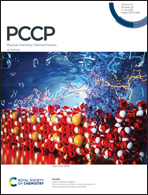The influence mechanism of the molecular structure on the peak current and peak potential in electrochemical detection of typical quinolone antibiotics†
Abstract
Antibiotic pollution in water has become an increasingly serious problem, posing a potentially huge threat to human health. Ofloxacin (OFL), norfloxacin (NOR), and enoxacin (ENX) are typical broad-spectrum quinolone antibiotics, which are frequently detected in various water environments. An electrochemical sensor is a rapid and effective tool to detect antibiotics in the aquatic environment. The molecular structure of target pollutants is an important factor affecting the detection performance of electrochemical sensors. Based on the electrochemical detection results of antibiotics (OFL, NOR, and ENX), we first used the molecular structure analysis method based on quantum chemistry to accurately identify the electronegativity and the electrocatalytic degree of the oxidizable (and non-oxidizable) functional groups of pollutants. We also clarified the influence mechanism of the molecular structure on the peak current and peak potential. These results can provide theoretical support for rapidly selecting electrodes with a suitable electrochemical window to efficiently detect trace organic pollutants (such as antibiotics) in water based on the molecular structure of the target pollutant.



 Please wait while we load your content...
Please wait while we load your content...